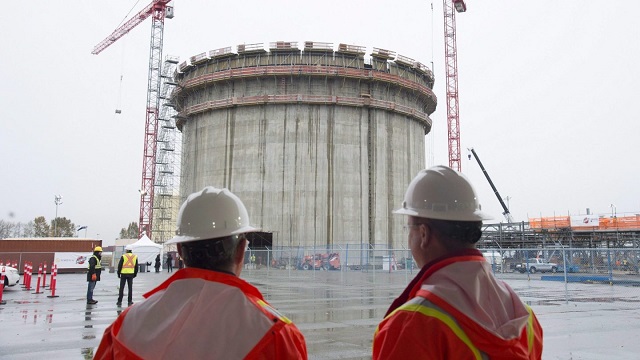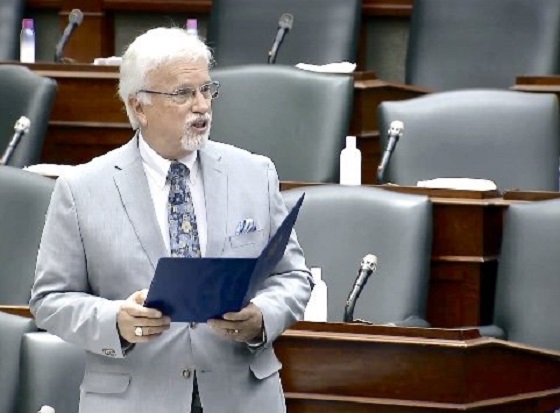Energy
Did the Environment Minister announce the end of Alberta’s Oil and Gas Industry at COP 27?

Steven Guilbeault (center) arrested after climbing the CN Tower for a Greenpeace protest on July 16, 2001.
PHOTO BY AARON HARRIS/THE CANADIAN PRESS
News Release From the Alberta Institute
Stop The Federal Cap On Oil And Gas
This week, Environment and Climate Change Minister, Steven Guilbeault, effectively announced the end of Alberta’s oil and gas industry.
In Egypt, at COP27, he announced that his government will cap oil and gas sector emissions from the end of next year, and work to reduce them after that.
Remember, even Justin Trudeau said that no country would find 173 billion barrels of oil in the ground and just leave them there.
But that, of course, was before he was Prime Minister.
Radical environmental activist Steven Guilbeault does believe we should leave 173 billion barrels of oil in the ground.
Now, yes, technically, he said he would cap and reduce emissions, not oil and gas production, and some energy companies are confident they can find efficiencies to allow them to continue producing some oil and gas without increasing emissions.
But anyone who’s been in the game long enough has seen the goalposts moved often enough to recognize another goalpost shifting when they see it, and that’s exactly what happened today.
How so?
Well, you would think Minister Guilbeault’s friends in the eco-activist industry – the same people who just a few years ago were calling for this cap on emissions – would be happy about this week’s announcement, wouldn’t you?
But no, these same people who were calling for exactly this policy just a few years ago actually attacked his announcement.
They think that this week’s announcement – the policy they were calling for until recently – is woefully inadequate.
They now want, you guessed it, a cap on production.
They don’t actually care about the level of carbon emissions, they don’t actually care whether emissions go down, they want the amount of oil and gas producedto go down.
This, fellow Albertans, is what Alberta is up against.
The radical eco-activist environmental movement doesn’t want Alberta’s oil and gas industry to be more environmentally friendly, they want Alberta’s oil and gas industry to die.
Meanwhile, having shifted the goalposts a dozen times already – the federal government’s environmental policies are as close to a complete ban on oil and gas as you can get, without actually banning it.
One more goalpost shift, and it will be an outright ban.
The environmental groups are pushing for that last final goalpost shift.
And Albertans are just supposed to trust the federal government that, despite all the previous times they shifted the goalposts, this time they definitely won’t.
The time to stand up for Alberta, and stand up for Albertans is now.
If we don’t do so right now, it might be too late.
In the 1980s, Alberta Premier, Peter Lougheed, fought for – and won – an amendment to the Canadian Constitution – Section 92A – that gave Alberta (and the other Provinces) the exclusive right to explore, develop, conserve, and manage their natural resources.
This amendment made clear that these resources belonged to the Provinces, not the federal government, and Alberta would not have signed on to the Constitution had that clause not been included.
Justin Trudeau and Steven Guilbeault do not believe in that clause in the Canadian Constitution.
They have already ignored it many times, and intend to continue to ignore it.
Justin Trudeau’s view is that Alberta can do whatever we want with our resources… as long as whatever we want to do is exactly what the federal government wants us to do.
And the federal Minister of Environment and Climate Change’s view is that we should leave them in the ground – all of them.
Enough is enough.
Now is the time for every Albertan – and the Alberta government – to stand up to the federal government.
If you agree, please join our campaign to stop the federal cap on oil and gas:
Please also consider forwarding this email to your friends, family, colleagues, and every Canadian.
Regards,
The Alberta Institute Team
Alberta
Official statement from Premier Danielle Smith and Energy Minister Brian Jean on the start-up of the Trans Mountain Pipeline

Canadian Energy Centre
North America LNG project cost competitiveness

Construction workers look on at the FortisBC Tilbury LNG expansion project in Delta, B.C., Monday, Nov. 16, 2015. CP Images photo
From the Canadian Energy Centre
Lower costs for natural gas, shipping and liquefaction give Canada an edge in the emerging global LNG market
Worldwide concerns about energy security have put a renewed focus on the international liquefied natural gas (LNG) industry. The global demand for LNG is expected to increase over the next few decades.
Global demand growth will be driven primarily by Asian markets where the need for LNG is expected to increase from 277 million tonnes (MT) in 2025 to 509 MT by 2050 (see Figure 1). By 2050 the demand for LNG in Europe will be 83 MT and in Africa 20 MT. In South America too, demand will increase – from 13 MT in 2025 to 31 MT in 2050.

Source: Derived from Rystad Energy, Gas and LNG Markets Solution.
In North America (Canada, Mexico, and United States) a number of LNG projects that are either under construction or in the planning stages will benefit from the rise in global LNG demand.
North American LNG production is expected to grow from 112 MT in 2025 to over 255 MT by 2050 (see Figure 2). In Canada, the LNG projects under construction or in the planning stages include LNG Canada Phases 1 & 2, Woodfibre LNG, Cedar LNG, the Tilbury LNG expansion, and Ksi Lisims LNG. Canada’s LNG production is expected to grow from just 2 MT in 2025 to over 43 MT by 2050. In the United States production is projected to increase from 108 MT in 2025 to 210 MT in 2050.

Source: Derived from Rystad Energy, Gas and LNG Markets Solution.
This CEC Fact Sheet uses Rystad Energy’s Gas and LNG Markets Solution¹ to benchmark the cost competitiveness of LNG projects that are under construction and proposed in Canada compared to other LNG projects under construction and planned elsewhere in North America. (Note that the content of this report does not represent the views of Rystad Energy.)
The LNG cost competitiveness benchmarking analysis used the following performance metrics:
- LNG plant free-on-board (FOB) cost break-even;
- Total LNG plant cost (for delivery into Asia and Europe).
The objective of this LNG cost competitiveness benchmarking is to compare the competitiveness of Canadian LNG projects against those of major competitors in the United States and Mexico. The selection of other North American LNG facilities for the benchmark comparison with Canadian LNG projects (LNG Canada, the Tilbury LNG Expansion, Woodfibre LNG, Cedar LNG, and Ksi Lisims LNG) is based on the rationale that virtually all Canadian LNG plants are under construction or in the planning stage and that they compare well with other North American LNG plants that are also under construction or are being planned between 2023 and 2050. Further, to assess the cost competitiveness of the various LNG projects more accurately, we chose only North American LNG facilities with sufficient economic data to enable such a comparison. We compared the cost competitiveness of LNG coming from these other North American projects with LNG coming from Canada that is intended to be delivered to markets in Asia and Europe.
1. Rystad Energy is an independent energy research company providing data, analytics, and consultancy services to clients around the globe. Its Gas and LNG Markets Solution provides an overview of LNG markets worldwide. The Solution covers the entire value chain associated with gas and LNG production, country and sector-level demand, and LNG trade flows, infrastructure, economics, costs, and contracts through 2050. It allows for the evaluation of the entire LNG market infrastructure, including future planned projects, as well as the benchmarking of costs for LNG projects (Rystad Energy, 2024).
Comparison of LNG project FOB cost break-even (full cycle)
Figure 3 provides a comparison of the free-on-board (FOB) cost break-even for LNG facilities under construction or being planned in North America. FOB break-even costs include upstream and midstream costs for LNG excluding transportation costs (shipping) as seen from the current year. Break-even prices assume a discount rate of 10 percent and represent the point at which the net present value for an LNG project over a 20- to 30-year period becomes positive, including the payment of capital and operating costs, inclusive of taxes.
Among the selected group of North American LNG projects are Canadian LNG projects with an FOB break-even at the lower end of the range (US$7.18 per thousand cubic feet (kcf)) to those at the higher end (US$8.64 per thousand cubic feet (kcf)).
LNG projects in the United States tend to settle in the middle of the pack, with FOB break-even between US$6.44 per kcf and US$8.37 per kcf.
Mexico LNG projects have the widest variation in costs among the selected group of projects, ranging from US$6.94 per kcf to US$9.44 per kcf (see Figure 3).

Source: Derived from Rystad Energy, Gas and LNG Markets Solution.
Total costs by project for LNG delivery to Asia and Europe
The total cost by LNG plant includes FOB cost break-even, transportation costs, and the regasification tariff. Figure 4 compares total project costs for LNG destined for Asia from selected North American LNG facilities.
Canadian LNG projects are very cost competitive, and those with Asia as their intended market tend to cluster at the lower end of the scale. The costs vary by project, but range between US$8.10 per kcf and US$9.56 per kcf, making Canadian LNG projects among the lowest cost projects in North America.
The costs for Mexico’s LNG projects with Asia as the intended destination for their product tend to cluster in the middle of the pack. Costs among U.S. LNG facilities that plan to send their product to Asia tend to sit at the higher end of the scale, at between US$8.90 and US$10.80 per kcf.

Source: Derived from Rystad Energy, Gas and LNG Markets Solution.
Figure 5 compares total project costs for LNG to be delivered to Europe from select North American LNG facilities.
Costs from U.S. LNG facilities show the widest variation for this market at between US$7.48 per kcf and US$9.42 per kcf, but the majority of U.S. LNG facilities tend to cluster at the lower end of the cost scale, between US$7.48 per kcf and US$8.61 per kcf (see Figure 5).
Canadian projects that intend to deliver LNG to Europe show a variety of costs that tend to cluster at the middle to higher end of the spectrum, ranging from US$9.60 per kcf to and US$11.06 per kcf.
The costs of Mexico’s projects that are aimed at delivering LNG to Europe tend to cluster in the middle of the spectrum (US$9.11 per kcf to US$10.61 per kcf).

Source: Derived from Rystad Energy, Gas and LNG Markets Solution.
Conclusion
LNG markets are complex. Each project is unique and presents its own challenges. The future of Canadian LNG projects depends upon the overall demand and supply in the global LNG market. As the demand for LNG increases in the next decades, the world will be searching for energy security.
The lower liquefaction and shipping costs coupled with the lower cost of the natural gas itself in Western Canada translate into lower prices for Canadian LNG, particularly that destined for Asian markets. Those advantages will help make Canadian LNG very competitive and attractive to markets worldwide.
-

 Alberta1 day ago
Alberta1 day agoAlberta’s vision for passenger rail
-

 COVID-192 days ago
COVID-192 days agoFormer Canadian lawmaker has no regrets about refusing COVID shot despite losing his job
-

 COVID-192 days ago
COVID-192 days agoPeckford: Hallelujah! Supreme Court of Canada to hear Newfoundland and Labrador charter case
-

 Alberta1 day ago
Alberta1 day agoThree Calgary massage parlours linked to human trafficking investigation
-

 Uncategorized1 day ago
Uncategorized1 day agoMaking Alberta a geothermal energy leader
-

 Alberta2 days ago
Alberta2 days agoCanada’s postal service refuses to help with Trudeau’s gun ban buyback program: report
-

 conflict18 hours ago
conflict18 hours agoColumbia on Lockdown After pro-Palestinian Protesters Take Over Building, Hold Janitors Hostage
-

 Canadian Energy Centre18 hours ago
Canadian Energy Centre18 hours agoNorth America LNG project cost competitiveness






